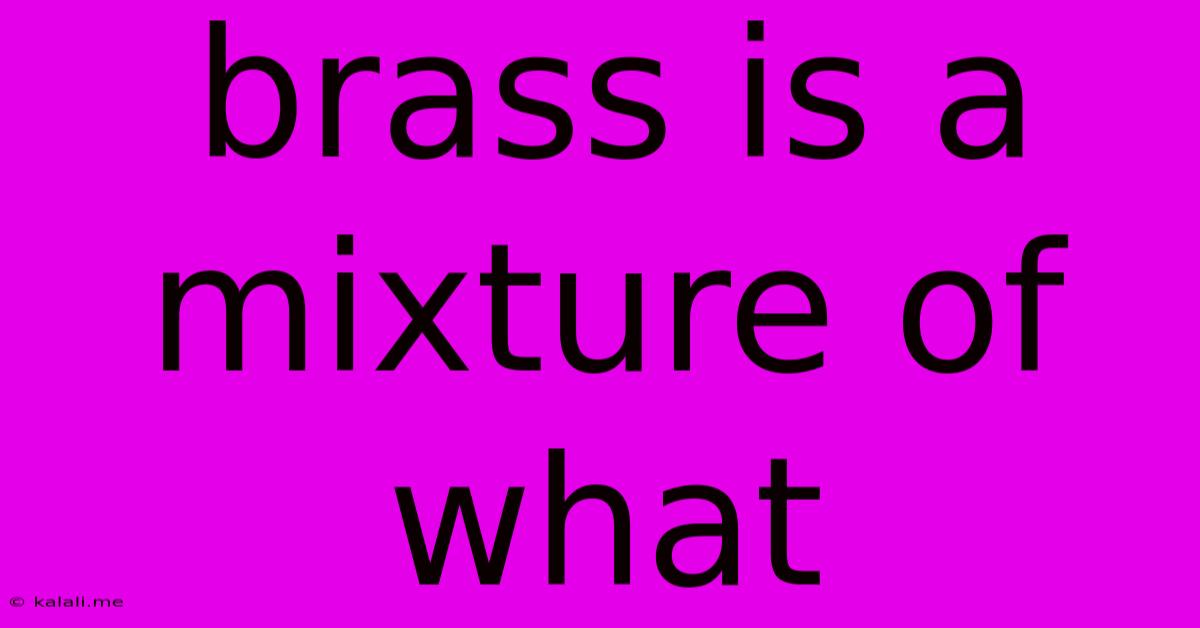Brass Is A Mixture Of What
Kalali
Jun 14, 2025 · 3 min read

Table of Contents
Brass: A Mixture of Copper and Zinc – Exploring its Composition and Properties
Brass is a remarkable alloy prized for its attractive golden hue, durability, and malleability. But what exactly is brass a mixture of? This comprehensive guide delves into the composition of brass, exploring the role of copper and zinc, and highlighting the diverse properties that make it such a versatile material. Understanding its fundamental makeup is key to appreciating its widespread applications in various industries.
The Primary Components: Copper and Zinc
At its core, brass is an alloy primarily composed of copper and zinc. The exact proportions of these two metals determine the specific properties of the resulting brass. While other elements might be added in smaller quantities to further modify its characteristics (more on that later), copper and zinc remain the defining components. The percentage of each metal significantly impacts the final product’s color, hardness, strength, and ductility.
The Role of Copper
Copper forms the base of most brass alloys, typically constituting between 50% and 90% of the mixture. It provides the characteristic golden color and contributes significantly to the alloy's overall strength and corrosion resistance. Copper’s inherent properties are enhanced and modified by the addition of zinc.
The Role of Zinc
Zinc, the other primary component, plays a crucial role in adjusting the brass's mechanical and physical properties. It increases the hardness and strength of the copper, while also influencing its machinability and casting characteristics. Increasing the zinc content generally results in a lighter color and improved ductility, but can also reduce corrosion resistance at higher concentrations.
Variations in Brass Composition: Creating Diverse Properties
The precise ratio of copper to zinc isn't fixed; it’s tailored to achieve specific properties. This allows for a wide range of brass alloys, each suited to different applications. For instance:
- High-zinc brasses: These contain a higher percentage of zinc, resulting in a brighter, paler yellow color and increased ductility. They are often preferred for applications requiring ease of shaping and forming.
- Low-zinc brasses: These have a higher copper content, leading to a richer, darker golden color and greater strength and corrosion resistance. They are commonly used in applications where durability and resistance to wear are paramount.
Beyond Copper and Zinc: Minor Alloying Elements
While copper and zinc are the fundamental ingredients, other elements are sometimes added in smaller amounts to further fine-tune the properties of brass. These minor additions can significantly impact the alloy’s strength, machinability, corrosion resistance, and color. Commonly used minor alloying elements include:
- Lead: Improves machinability.
- Tin: Enhances corrosion resistance and strength.
- Manganese: Increases strength and hardness.
- Aluminum: Improves corrosion resistance, strength, and ductility.
- Silicon: Improves castability and fluidity.
The inclusion of these elements creates specialized brass alloys, each tailored for specific industrial applications.
Conclusion: The Versatility of Brass
Brass, a versatile alloy with a simple yet impactful composition, finds applications in diverse fields, from musical instruments and plumbing fixtures to electrical components and ammunition casings. The ability to precisely control the ratio of copper and zinc, and the incorporation of minor alloying elements, allows manufacturers to tailor the properties of brass to meet the demands of specific applications. Understanding the fundamental mixture of copper and zinc is therefore crucial to appreciating the remarkable versatility and widespread use of this valuable material.
Latest Posts
Latest Posts
-
Which Of The Following Statements Concerning Slate Is Not True
Jun 15, 2025
-
What Are The Factor Pairs Of 100
Jun 15, 2025
-
Which Statement About Case Studies Is True
Jun 15, 2025
-
Difference Between Ascending And Descending Limb Of Loop Of Henle
Jun 15, 2025
-
Difference Between Physical Geography And Human Geography
Jun 15, 2025
Related Post
Thank you for visiting our website which covers about Brass Is A Mixture Of What . We hope the information provided has been useful to you. Feel free to contact us if you have any questions or need further assistance. See you next time and don't miss to bookmark.